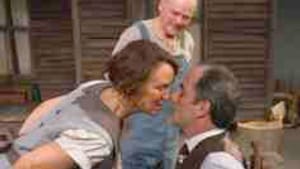Stay in the Loop
BSR publishes on a weekly schedule, with an email newsletter every Wednesday and Thursday morning. There’s no paywall, and subscribing is always free.
The core of O'Neill's compassion
"Moon For the Misbegotten' at the Arden (1st review)

It was no fun to belong to the decaying gentry of pre-revolutionary Russia, as Chekhov pointed out. Nor was it necessarily happier to be part of the post-famine Irish exodus to America, whose accompanying demons decidedly included demon rum.
Eugene O'Neill was their chronicler, and, like Chekhov, he tended to tell the same story over and over again. We keep listening to both men, though, because their tale, however circumscribed by time and place, speaks to a universal condition we can all recognize: the human one.
Chekhov's protagonists are the elite of a dying order. Their manners are correspondingly refined, and their hearts break on stage gently though completely, like a perfectly cracked egg.
O'Neill's Irish carry what manners they have as an ironic banner above the truth of a knowledge they can never shake: that they are the sons of misery and to misery eternally born. Even when they rise in their adopted country, they can't believe their fortune will last and so do their best to undo it. Their truth is only the bottom of a bottle away.
Like Chekhov, O'Neill centers his dramas on family conflict. In A Moon for the Misbegotten, this conflict is off to the side, though never out of sight.
No suitors, but one admirer
The Hogans are poor tenant farmers in Prohibition-era Connecticut. Father Phil watches his sons leave— good riddance to them— and as the play opens, he's left only with his hefty daughter Josie, who does most of the actual work. She has no suitors, and hence no prospects.
She does have an admirer, though, in her landlord. He is none other than the James Tyrone Jr. of O'Neill's most celebrated play, Long Day's Journey into Night, who, now middle-aged, carries his family ghosts like a peddler's pack on his back.
A little more plot business brings Tyrone and Josie together on a summer night. Josie is hopelessly in love with him, and Tyrone, for his part, romantically idealizes her as a combination of earth mother and tenderhearted virgin. It's a mismatch, but there are more improbable romances under the sun.
Tyrone, though, can only approach women as vessels of purity or whores, and what he really wants of Josie is absolution. He seeks it not in order to live, however, but for permission to die, and Josie, in granting it, forswears the light in her own life.
Summit of American tragedy
Of course all this is mawkish and melodramatic, like most O'Neill plots— even laughable by modern standards. But O'Neill is a soaring poet, and for that one must forgive him, too, almost everything.
The long, climactic scene between Josie and Tyrone that occupies most of Act II is one of the summits of tragedy in American theater. Having seen Wendy Hiller and Jason Robards in the play, my own standards are high, but the Arden's performers, Grace Gonglewski and Eric Hissom, acquit themselves very well.
Gonglewski takes full command of Josie, both physically and emotionally; and Hissom, though seemingly slower to hit his stride, paces his character along, and captures Tyrone's drunken alternations of hunger and self-loathing in slashing strokes of timing. They've played together before in the Arden's past productions of Major Barbara and Hedda Gabler, but this is their finest collaboration yet.
Between intimacy and solitude
Josie and James come as close to each other as human beings can in their long, lonely night, while remaining finally separate. Each understands a part of the other that no one else can reach, but neither can bridge the distance. Josie must settle for a compassion that will never fulfill itself in love, and James for a fleeting moment of grace and reprieve. Under Matt Pfeiffer's sensitive direction, Gonglewski and Hissom finely walk the line between intimacy and solitude that divides them.
H. Michael Walls, another Arden veteran, provides able support and comic relief as Phil Hogan. Sean Lally and Allen Radway are a bit out of their depth beside the other performers, but their roles are minor. The set by Matt Saunders is simple, with a couple of rocks to suggest the hardscrabble New England soil. Lighting is critical to this play, and Thom Weaver mixes his palettes well.
A Moon for the Misbegotten has been rather lost among O'Neill's late plays; it's actually his last completed work, and when James walks off to the inn to find another drink and Josie turns back to her chores, O'Neill takes his leave of us.
More concentrated than Long Day's Journey into Night and less grimly disillusioned than The Iceman Cometh, it is no mere pendant to the former but a work that touches the core of O'Neill's compassion. The opportunity to see it in a satisfying production should not be missed.♦
To read another review by Alaina Mabaso, click here.
To read another review by Jackie Atkins, click here.
Eugene O'Neill was their chronicler, and, like Chekhov, he tended to tell the same story over and over again. We keep listening to both men, though, because their tale, however circumscribed by time and place, speaks to a universal condition we can all recognize: the human one.
Chekhov's protagonists are the elite of a dying order. Their manners are correspondingly refined, and their hearts break on stage gently though completely, like a perfectly cracked egg.
O'Neill's Irish carry what manners they have as an ironic banner above the truth of a knowledge they can never shake: that they are the sons of misery and to misery eternally born. Even when they rise in their adopted country, they can't believe their fortune will last and so do their best to undo it. Their truth is only the bottom of a bottle away.
Like Chekhov, O'Neill centers his dramas on family conflict. In A Moon for the Misbegotten, this conflict is off to the side, though never out of sight.
No suitors, but one admirer
The Hogans are poor tenant farmers in Prohibition-era Connecticut. Father Phil watches his sons leave— good riddance to them— and as the play opens, he's left only with his hefty daughter Josie, who does most of the actual work. She has no suitors, and hence no prospects.
She does have an admirer, though, in her landlord. He is none other than the James Tyrone Jr. of O'Neill's most celebrated play, Long Day's Journey into Night, who, now middle-aged, carries his family ghosts like a peddler's pack on his back.
A little more plot business brings Tyrone and Josie together on a summer night. Josie is hopelessly in love with him, and Tyrone, for his part, romantically idealizes her as a combination of earth mother and tenderhearted virgin. It's a mismatch, but there are more improbable romances under the sun.
Tyrone, though, can only approach women as vessels of purity or whores, and what he really wants of Josie is absolution. He seeks it not in order to live, however, but for permission to die, and Josie, in granting it, forswears the light in her own life.
Summit of American tragedy
Of course all this is mawkish and melodramatic, like most O'Neill plots— even laughable by modern standards. But O'Neill is a soaring poet, and for that one must forgive him, too, almost everything.
The long, climactic scene between Josie and Tyrone that occupies most of Act II is one of the summits of tragedy in American theater. Having seen Wendy Hiller and Jason Robards in the play, my own standards are high, but the Arden's performers, Grace Gonglewski and Eric Hissom, acquit themselves very well.
Gonglewski takes full command of Josie, both physically and emotionally; and Hissom, though seemingly slower to hit his stride, paces his character along, and captures Tyrone's drunken alternations of hunger and self-loathing in slashing strokes of timing. They've played together before in the Arden's past productions of Major Barbara and Hedda Gabler, but this is their finest collaboration yet.
Between intimacy and solitude
Josie and James come as close to each other as human beings can in their long, lonely night, while remaining finally separate. Each understands a part of the other that no one else can reach, but neither can bridge the distance. Josie must settle for a compassion that will never fulfill itself in love, and James for a fleeting moment of grace and reprieve. Under Matt Pfeiffer's sensitive direction, Gonglewski and Hissom finely walk the line between intimacy and solitude that divides them.
H. Michael Walls, another Arden veteran, provides able support and comic relief as Phil Hogan. Sean Lally and Allen Radway are a bit out of their depth beside the other performers, but their roles are minor. The set by Matt Saunders is simple, with a couple of rocks to suggest the hardscrabble New England soil. Lighting is critical to this play, and Thom Weaver mixes his palettes well.
A Moon for the Misbegotten has been rather lost among O'Neill's late plays; it's actually his last completed work, and when James walks off to the inn to find another drink and Josie turns back to her chores, O'Neill takes his leave of us.
More concentrated than Long Day's Journey into Night and less grimly disillusioned than The Iceman Cometh, it is no mere pendant to the former but a work that touches the core of O'Neill's compassion. The opportunity to see it in a satisfying production should not be missed.♦
To read another review by Alaina Mabaso, click here.
To read another review by Jackie Atkins, click here.
What, When, Where
A Moon for the Misbegotten. By Eugene O’Neill; Matt Pfeiffer directed. Through February 27, 2011 the Arden Theatre, 40 N. Second St. (215) 922-1122 or www.ardentheatre.org.
Sign up for our newsletter
All of the week's new articles, all in one place. Sign up for the free weekly BSR newsletters, and don't miss a conversation.

 Robert Zaller
Robert Zaller